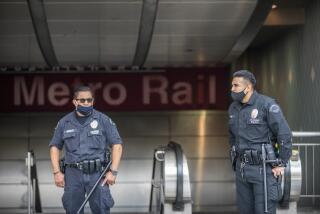Safety first at Metrolink
- Share via
It’s been a year and a half since a Metrolink commuter train slammed into a Union Pacific freight engine near Chatsworth, killing 25 people and injuring 135, but the reverberations continue. The latest is a threat by conductors and engineers to boycott personality tests the company has ordered them to take if they want to keep their jobs. Amtrak, the contractor that will start operating Metrolink’s lines June 26, administers the tests to all new hires, as the crews currently running the trains technically would be -- even though many of them worked for Amtrak the last time it was Metrolink’s contractor.
Metrolink workers say they don’t see a connection between the tests and the safe operation of trains, so they fear it’s a ruse to get rid of some veteran employees. But in fact it’s entirely reasonable for the company to want to screen out potentially risky personnel before entrusting them with the lives of Metrolink passengers. What’s less clear, however, is whether testing people who’ve been on the job for numerous trouble-free years would be an effective way to bring hidden liabilities to the surface.
Investigators blamed the September 2008 collision on the veteran engineer at the controls, Robert Sanchez, who apparently missed a signal to stop the train because he was sending a text message. Metrolink has pledged multiple steps in response, such as adding crash-avoidance technology and putting cameras in all its locomotives. It decided to introduce personality tests when it hired Amtrak, which has been administering them to engineer applicants since 2002 and conductor applicants since 2004.
The test for engineers is designed to explore “work tendencies, habits and personality traits,” and the one for conductors aims to determine “attitudes toward theft, drug use, treatment of customers, etc., under a variety of work-based conditions.” As with any attempt to predict behavior, they’re not precise or foolproof. That’s why such measures are typically used before people are hired, when employers can only guess as to how they’ll perform. It’s a stretch to think that the tests could reveal something about a veteran employee that managers haven’t already learned. If they could, you would think Amtrak would have required its existing employees to take them alongside new applicants. It hasn’t.
Given the amount of training required, it would be hard for Metrolink and Amtrak to find substitutes for many of the nearly 130 engineers and conductors now working the routes. That’s why it’s hard to see an ulterior motive behind the tests. Workers should be willing to take them; refusing to do so just seems obstinate in the face of Metrolink’s efforts to upgrade safety. But management should commit to reviewing the test results in the context of each employee’s record on the job, which seems like a far better indicator of his or her safety risks.
More to Read
Sign up for Essential California
The most important California stories and recommendations in your inbox every morning.
You may occasionally receive promotional content from the Los Angeles Times.













